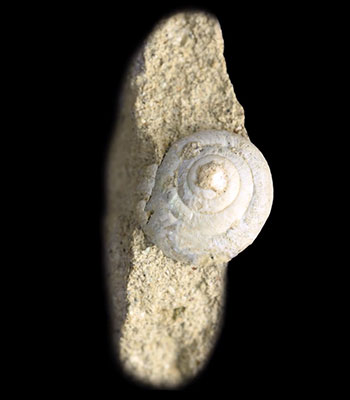Last updated: April 15, 2020
Lesson Plan
How Living Things Become Fossils

- Grade Level:
- Upper Elementary: Third Grade through Fifth Grade
- Subject:
- Science
- Lesson Duration:
- 90 Minutes
- Additional Standards:
- 3rd Grade: 3-LS4-1, 3-LS4-2, and 3-LS4-3
- Thinking Skills:
- Understanding: Understand the main idea of material heard, viewed, or read. Interpret or summarize the ideas in own words.
Essential Question
How do plants and animals become fossils?
Objective
Identify fossils and how they are formed.
Background
Teachers should read and review information in A Fossil’s Journey with students.
Preparation
Materials
Paper Cups
Liquid Mud or Clay- of two or more contrasting colors
Bones, Shells, Leaves- or other possible fossils
Plastic Spoons, Toothpicks, or Small Nails
Set Up
Have students bring in small leaves, bones, and/or shells to act as their “fossils”. Explain that they are going to simulate a lake in which mud is slowly being deposited. In this lake live plants and animals that fall to the bottom when they die. Once at the bottom, dead organisms are buried beneath mud and sediment.
Procedure
Step One: Distribute to each student a paper cup and a bit of each colored mud.
Step Two: Have students add mud to their cup in increments, alternating colors and allowing mud to settle between each addition. The students may add their fossils to the cup at any point in the sedimentation process or you may announce specific points in which they are to do so.
Step Three: After all fossils are buried beneath mud, allow the sediment to dry. Explain to the students that the drying of the mud simulates the turning of sediment into rock. Drying will take place much faster if the cups are placed in a warm dry place, even a warm oven, for a few hours.
Step Four: Once drying is complete, have students excavate their fossils by tearing away the paper cups and digging at the mud with a plastic spoon.
Step Five: As a class, discuss the following questions together: 1) How much time did it take to make your sedimentary rocks and fossils? 2) How much time do you think it takes in nature? 3) Was it hard to excavate your fossils from the sediment? Did any of your fossils get damaged in the process?
Step Six: Complete Making a Trace Fossil Lesson Plan.
Step Seven: Complete Some Parts Make Better Fossils than Others Lesson Plan.
Step Eight: Complete the Post-Unit Questions found on A Fossil's Journey.
Vocabulary
Clastic Sediments: sediments result from the breakdown, through weathering, of pre-existing rocks.
Curator: a museum scientist.
Diagenesis: everything that happens to sediment after it is deposited. A potential fossil may be dissolved in the process of diagenesis, and other times it may become mineralized.
Fossil: any naturally occurring evidence of past life. Fossils need not be mineralized or enclosed in rock.
Organic sediments: pieces of tissues of plants or animals such as leaf litter on a forest floor.
Paleontologists: scientists who study fossils to understand the history of life on Earth.
Preparation: when paleontologist clean dirt and surrounding rocks off the fossil, glue it together (if broken) and store it.
Prospecting: to search the ground for fossils.
Metamorphic rocks: rocks changed by heat and pressure.
Mineralization or Petrification: the condition when a fossil has effectively turned to stone.
Trace Fossil: an impression of the animal or plant after its death such as a natural mold of a shell.
Sedimentary Structures: non-biological processes preserved in rocks like ancient ripple marks, mud cracks, or raindrops preserved in rock. They do not represent activities of living things, and they are not trace fossils.
Contact Information
Email us about this lesson plan
